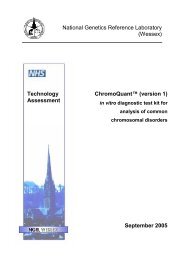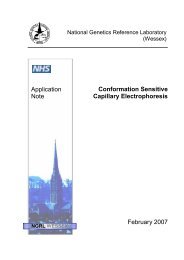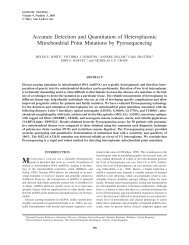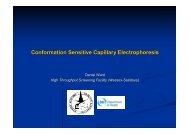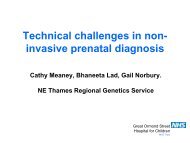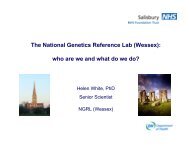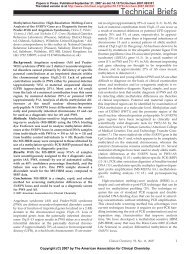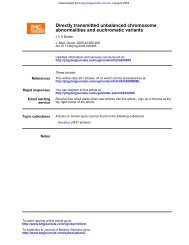Analysis of BRCA and HNPCC mutations
Analysis of BRCA and HNPCC mutations
Analysis of BRCA and HNPCC mutations
You also want an ePaper? Increase the reach of your titles
YUMPU automatically turns print PDFs into web optimized ePapers that Google loves.
<strong>Analysis</strong> <strong>of</strong> <strong>HNPCC</strong> <strong>and</strong> <strong>BRCA</strong> <strong>mutations</strong>:screening <strong>of</strong> unclassified variants (UVs)for splicing defectsMario TosiInserm U614, Faculté de Médecine et de Pharmacie de RouenInstitut Hospitalo-Universitaire de Recherche Biomédicale de RouenLondon, 3rd March 2008Eurasnet workshop : RNA splicing <strong>and</strong> genetic diagnosisWorshop organizers : Diana Baralle, Nick Cross
<strong>HNPCC</strong> (Hereditary Non Polyposis Colorectal Cancer)OR LYNCH SYNDROME2 - 5 % <strong>of</strong> colorectal cancerscrccrccrc < 50 years- Colon rectum +++- Endometrium +++- Small bowel- Urinary tract- Stomach- Ovary- Biliary tractAutosomal dominant genetic predispositionMLH1 (3p21)MSH2 (2p22-p21)MSH6 (2p16)PMS2 (7p22)MMR (mismatch repair) genesMLH1MSH2MSH6PMS2
MMR GENE ALTERATIONS IN THE LYNCH SYNDROMEData for families recruited with stringent criteria (Amsterdam)-Pathogenic point <strong>mutations</strong>MLH1 25 %MSH2 25 %MSH6, PMS2 5 %- MSH2 gene rearrangements 10 %- MLH1 rearrangements < 4 %QMPSFMLPA< 70 %+ Many variants <strong>of</strong> unknown significance (UVs)Missense variants, silent (at the level <strong>of</strong> translation), intronic variantsDi Fiore et al., J Med Genet 2004, 41:18-20
SPLICING REGULATORY ELEMENTSISE Intronic Splicing EnhancerISS Intronic Splicing SilencerESE Exonic Splicing EnhancerESS Exonic Splicing SilencerISEISSESE ESSGU A YRYYRY AG+ -GUAG
LEVELS OF ANALYSISPATIENT RNAin most cases not availableIn silico predictionsnot sufficient for diagnosisnot always accurateFunctional splicing assaystime-consuming but very usefulSplicing reporter minigene assays, reviewed in:Baralle <strong>and</strong> Baralle J. Med. Genet. 2005;42;737-748Cooper TA. Methods 2005; 37:331-340
SPLICING ASSAYPatient blood samples (PaxGene) for RNA<strong>of</strong>ten not availablePatient DNABamHIExon + mutationMluI150 bp150 bpCMVEx2Ex3PolyAdenylationpCDNA3.1(-) / SERPING1/C1NH
SPLICING ASSAYWild-type exon1) CloningMutant exon2) Transient transfectioninto HeLa cellsPuromycin10ug/mL 5h303) RT-PCR after 24hEx2Ex XEx3Ex2Ex34) Agarose gel – SYSTEMATIC sequencing
EXAMPLES OF VARIANTS THAT MODIFYOR GENERATE EXON BOUNDARIESExon + mutationBamHI MluI150 bp150 bpCMVP1 P2PolyApCAS vector(pcDNA3.1(-) / SERPING1/C1NH)pCAS vectorEx 10 wt MLH1c.884+4A>GEx 15 wt MLH1c.1731G>Ac.1731+5G>AEx 11 wt MSH2c.1759G>CEx 13 wt MSH2c.2006-6T>CEx 15 wt MSH2c.2634+5G>TMLH1 MSH2All RT-PCR products are sequencedTournier et al. (2008). Human Mutation, in press
MLH1, MSH2 VARIANTS ANALYSED (FEB. 2008)74 Missense <strong>mutations</strong> 16 Silent <strong>mutations</strong> 34 Intronic <strong>mutations</strong>5 single codon deletionsother than conserved AG/GT1 del/ins130 MLH1 (73), MSH2 (57) variants analysed33 / 130 (25%) affect splicing27 Alteration <strong>of</strong> splice sites, orGeneration <strong>of</strong> new splice sites, orActivation <strong>of</strong> crytpic splice site6 Mutations <strong>of</strong> putative splicingregulatory elements
MUTATIONS OF PUTATIVE SPLICING REGULATORY ELEMENTSMLH1Exon 10, 3rth exon position4th exon positionIn silico predictionsVariantESEfinderRescueESEPESXASSAc.793C>T----c.794G>ASC35, SRp40 abolished--SC35pCAS splicing assayc.793C>T : partial exon 10 skipping +++c.794G>A : partial exon 10 skipping ++VectorEx 10 WT MLH1c.793C>Tc.794G>AIdentification <strong>of</strong> a new ESE element ?
MUTATIONS OF PUTATIVE SPLICING REGULATORY ELEMENTSEffect <strong>of</strong> four MLH1 or MSH2 exonic variants<strong>and</strong> one MLH1 intronic UV in 3 different cell typesEx 9 WT MLH1c.790+10A>GEx 10 WT MLH1c.793C>Tc.794G>AEx 11 WT MLH1c.988_990delEx 5 WT MSH2c.815C>TVectorHeLaDLD1COS7Same variants in Hela cells usig pSPL3 : similar results
SC35-3xc.840C>TVALIDATION OF THE ESE-DEPENDENT SPLICING ASSAYPutative ESE sequence (~30 bp)EcoRIBamHICMVEx1Ex2PolyApcDNA-DupMiddle exon…cacccttagGCTGAATTC ( ) GGATCCGGCAGgttggtatc…SMN1Ex 7MCADEx 5SF2/ASF-3xEmptyBR2 Int 11wtwtc.351A>Cc.351A>Cc.362C>Tc.362C>TInteraction ESS-ESENielsen et al. (Andresen BS) Am J Hum Genet 80:416 (2007)
IDENTIFYING ESE ELEMENTS OF MLH1 AND MSH2Sequences to be tested (~30bp) inserted into a central exon,which is strictly dependent on presence <strong>of</strong> a ESE~ 30 pbVecteurExon 10 MLH1 WTc.793C>Tc.794G>Ac.988_990delc.815C>TExon 11 MLH1 WTExon 5 MSH2 WTpSPDUPHeLaWildtype sequence : exon inclusion3 new ESE elements found in this workDemonstration that 11 previously published <strong>mutations</strong> <strong>of</strong> MLH1 ou MSH2are within ESE elementsTournier et al. (2008). Human Mutation, in press
COMPARISONS WITH PATIENT RNA DATA130 MLH1, MSH2 variants analysed25 % (31 / 130) variants affect splicing37 / 130 variants tested on patient RNA35 Concordant results 2 Discordant results(but NMD not prevented)
APPLICATIONS TO <strong>BRCA</strong>1 AND <strong>BRCA</strong>2French Network Breast cancer geneticsWe compared patient RNA analyses <strong>and</strong> the minigene assayRouen + Caen (Dr. A. Hardouin)20 variants <strong>BRCA</strong>1, <strong>BRCA</strong>2 (17 families)Analysed in parallel onPatient RNAEx vivo minigene assay6 Variants affect splicing. Perfect agreementbetween in vivo <strong>and</strong> ex vivo data
EXAMPLE 1<strong>BRCA</strong>2 c.316+5G>C, IVS3Patient RNAMinigene assay5’UTR-ex5550 bp301 bp ∆ ex 3VE3+5G>CVex2-ex5, monoallelic514 bp265 bpC1 C2 P∆ ex 3wtMC1 C2 PNo normal mRNA expressed from mutant allele, pathogenicC. Bonnet, S. Krieger et al., revised manuscript submitted
EXAMPLE 2<strong>BRCA</strong>2 c.9501+3A>T (IVS25+3A>T)Patient RNART ex 23-ex 27Minigene assay+3A>TE25634 bp389 bp∆ ex 25C1 C2 PwtMMinigene assay : ~ 50% normal mRNA from mutant allelePartial splicing defect, still unclassified
DISCREPANCIES BETWEEN IN SILICO, IN VIVO AND EX VIVO<strong>BRCA</strong>1 c.670+8C>T (IVS10)Several in silico predictions :New Dss at +6, <strong>of</strong> samestrength as natural oneRT-PCR on patient RNA :Only natural Dss used+ Automated Splice Site AnalysesUsing s<strong>of</strong>ware « Alamut » from Interactive Bios<strong>of</strong>twarepCAS Minigene splicing assay :Only natural Dss usedUnlikely to be pathogenicBut this variant promotesinclusion, both in vivo <strong>and</strong> inthe minigene assay. Does itaffect an ISS?
SUMMARYLarge numbers <strong>of</strong> UVs screened with minigene assay130 in MLH1, MSH2 <strong>and</strong> 20 in <strong>BRCA</strong>1/2Good concordance with patient RNA data35/37 for MLH1, MSH2 <strong>and</strong> 20/20 for <strong>BRCA</strong>1/225% <strong>of</strong> UVs classified as splicing defectsMainly splice site alterations, activations <strong>of</strong> cryptic sitesor generation <strong>of</strong> new sitesFive <strong>mutations</strong> found in new exonic regulatory elementsDefinition <strong>of</strong> 12 ESE-containing short regions8 in MLH1, 4 in MSH2
ADVANTAGES OF MINIGENE ASSAYVery useful for screening UVs, because in most casespatient RNA is not availableWhen patient RNA is available, minigene assay facilitatesthe interpretation, because monoallelicAlthough exons are tested in heterologous context,good concordance with patient RNA dataAllows evaluation <strong>of</strong> in silico predictionsAlgorithms predicting 5’ <strong>and</strong> 3’ splice sites : rather accurateAlgorithms predicting ESE, ESS : neither sensitive nor specific
INTERPRETATION OFTEN REQUIRESAdding genetic evidence:segregation, co-occurrence <strong>of</strong> déléterious changesAdding information obtained from tumours(e.g. for <strong>HNPCC</strong>: IHC, microsatellite instability…)Interrogating databasesFrequent meetings <strong>of</strong> network members
Inserm U614Faculté de Médecine, RouenService de Génétique, CHU RouenIsabelle TournierMyriam VezainCéline BonnetAudrey KillianAlex<strong>and</strong>ra MartinsStéphanie Baert-DesurmontMario TosiThierry FrébourgConsultations d’OncogénétiqueDominique Stoppa-LyonnetInstitut Curie, ParisCatherine DugastCentre Eugène Marquis, RennesRosetteLidereau,Centre René Huguenin, FNCLCC,St-CloudCancéropôle Nord-OuestAgnès Hardouin, Sophie KriegerCentre François Baclesse, CaenRéseau laboratoires <strong>HNPCC</strong>Sylviane OlschwangInstitut Paoli-Calmettes, MarseilleMarie-Pierre BuisineCHU, LilleQing WangCentre Léon Bérard, LyonJean-Marc ReyCHU Hôpital Arnaud de Villeneuve,MontpellierOlivier CaronCHU Hôpital Civil, StasbourgChristophe PhilippeCHU, NancyStéphane BézieauCHU, NantesIGMM, UMR 5535, MontpellierJohann SoretJamal Tazi



